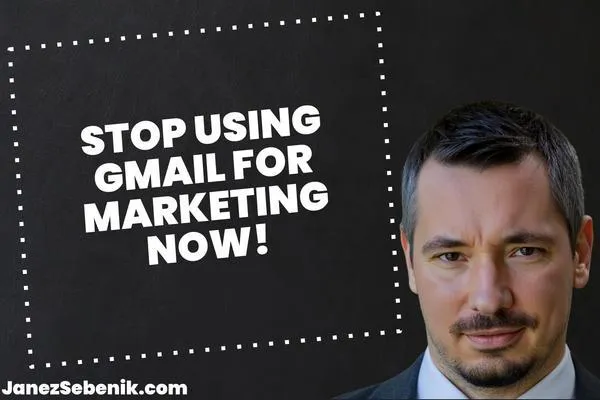
Why not use Gmail for email marketing?
Gmail is great for personal emails. But for email marketing? Not so much. You might think it's an easy way to reach your customers. Think again.
Using Gmail for email marketing can hurt your business and limit your growth. It's not designed for sending bulk emails or managing large contact lists. You'll face problems with delivery rates, tracking, and legal compliance.
Want to take your email marketing to the next level? You need tools made for the job.
Specialized email marketing platforms offer features Gmail can't match. They help you create better campaigns, reach more people, and grow your business faster.
Key Takeaways
Gmail lacks features needed for effective email marketing campaigns
Using Gmail can lead to delivery issues and legal problems
Specialized email marketing tools offer better results and scalability
Limitations of Gmail for Business Scale
Gmail has some big drawbacks for growing businesses. You might hit roadblocks that slow you down and make you look unprofessional.
Sending Limits and Potential for Spam
Gmail caps your daily email sends. This is a pain when you're trying to reach lots of people. You get 500 emails per day with a free account. That's not much for a real business.
Google Workspace bumps it up to 2,000. But that's still tight for serious email marketing. If you blast too many emails, Gmail might flag you as spam. Yikes!
Your messages could end up in junk folders. That's bad news for your open rates. You need better email deliverability to grow your business.
Personal Accounts vs. Professional Presence
Using a personal Gmail for business? It's like showing up to a fancy dinner in sweatpants. Not a good look.
Your clients expect professionalism. A @gmail.com address screams "amateur hour". It doesn't inspire trust or confidence in your brand.
Plus, you're missing out on brand recognition. Every email is a chance to reinforce your company name. Don't waste it with a generic address.
Professional email addresses make you look legit. They show you're serious about your business.
Email Design and Customization Shortfalls
Gmail's built-in design options are basic. You can't create eye-catching emails that wow your audience.
There's no easy way to make custom templates. You're stuck with plain text or simple layouts. That's not gonna cut it for pro marketing emails.
Want to add your logo or brand colors? Good luck. Gmail makes it tough to create a consistent brand look.
You can't track opens or clicks either. Without data, you're flying blind on your campaign performance. That's no way to improve your marketing game.
Analytics and Reporting Constraints
Gmail's free version isn't built for serious email marketing. It lacks the tools you need to track your campaigns and measure success. Let's dive into why this matters.
Tracking Engagement and Performance
You're flying blind with Gmail. It doesn't tell you who opened your emails or clicked your links. That's like trying to sell without knowing if anyone's buying.
Gmail analysis is crucial for not wasting your time and money. But Gmail won't show you open rates or click-through rates. These are key to understanding if your emails are hitting the mark.
Want to know which subject lines work best? Tough luck. Gmail won't tell you. You're left guessing what makes your subscribers tick.
A/B testing? Forget about it. You can't compare different versions of your emails to see what performs better. It's like shooting in the dark and hoping you hit something.
Evaluating Email Marketing Success
Gmail leaves you clueless about your email marketing metrics. You can't track conversions or see how much money your campaigns are making.
ROI? What's that? With Gmail, you have no way to measure if your efforts are paying off. It's like running a business without checking your bank account.
You can't segment your audience or see which groups respond best to your emails. That means you're treating everyone the same, missing out on personalized strategies.
Want to know when your subscribers are most likely to open emails? Gmail won't tell you. You might be sending at the worst possible times without even knowing it.
Compliance and Legal Issues
Email marketing laws are no joke. Break them and you're in for a world of hurt. Let's dive into what you need to know to keep your campaigns on the right side of the law.
Navigating GDPR and CAN-SPAM
The CAN-SPAM Act is like the sheriff of email marketing in the US. Break its rules and you could face fines up to $51,744 per email. Yikes!
Here's what you need to do:
Don't use deceptive subject lines
Identify your message as an ad
Include your physical address
Make it easy to unsubscribe
GDPR is Europe's data protection law. It's stricter than CAN-SPAM. You need explicit consent to send marketing emails. No pre-checked boxes allowed!
Remember, if you're using Gmail for email marketing, you're responsible for following these laws. Most email marketing platforms handle compliance for you. Gmail doesn't.
Understanding CASL Regulations
CASL is Canada's anti-spam law. It's like GDPR's cousin, but with its own quirks.
Key points:
Get express consent before sending emails
Provide clear identification
Include an unsubscribe mechanism
Penalties for breaking CASL? Up to $10 million Canadian dollars. That's enough to make anyone sweat!
Using Gmail for email marketing campaigns puts all the compliance work on you. It's a lot to keep track of. One slip-up could cost you big time.
Stick with a proper email marketing platform. They'll help you navigate these legal minefields. You'll sleep better at night knowing you're not accidentally breaking any laws.
Contact Management and List Segmentation
Gmail wasn't built for big-time email marketing. It's like trying to use a spoon to dig a hole. You need the right tools to manage contacts and segment your list effectively.
The Challenge of Large-Scale List Management
Ever tried herding cats? That's what managing a huge email list in Gmail feels like. You've got thousands of contacts, but no good way to organize them. It's a mess.
Gmail's contact system is basic. It's fine for personal use, but for marketing? Not so much.
You can't easily:
Tag contacts
Create custom fields
Sort by engagement
Remove inactive subscribers
Without these features, your list becomes a jumbled mess. You can't tell who's who or what they want.
Effective Segmentation for Targeted Marketing
Segmentation is the secret sauce of email marketing. It's how you send the right message to the right people.
With Gmail, you're stuck sending the same email to everyone. Boring!
Pro marketers use segmentation to:
Boost open rates
Increase click-throughs
Improve conversions
You can segment based on behavior, like past purchases or email engagement. Or by demographics, interests, or location.
But Gmail? It's got none of that. You're flying blind, sending generic emails that nobody wants to read.
Integration and Automation Limitations
Gmail's got some serious drawbacks when it comes to email marketing. You'll face hurdles with manual processes and limited tool integration. Let's dive in.
Inefficient Manual Processes
Gmail's not built for mass email campaigns. You'll be stuck doing everything by hand. Want to send personalized emails to 1000 people? Good luck with that.
Copy-pasting names and details? That's a recipe for mistakes and wasted time. And forget about automating follow-ups. Gmail just wasn't made for it.
Sure, you've got Smart Compose and some basic templates. But that's kid stuff compared to real email marketing tools.
Think about tracking opens and clicks. With Gmail, you're flying blind. No easy way to see who's engaging with your emails. That's marketing 101, and you're missing out.
Lack of Third-Party Email Marketing Tools Integration
You know those cool email marketing platforms? The ones with all the fancy features? Yeah, Gmail doesn't play nice with those.
Want to use a drag-and-drop editor to create stunning emails? Tough luck. Gmail's stuck in text-only land. No easy way to add images, buttons, or cool layouts.
And forget about integrating with your CRM. Gmail's not having it. You can't sync your contact lists or track customer interactions.
A/B testing? Nope. Automated segmentation? Dream on. These are basics in the email marketing world, but Gmail's not invited to the party.
You're also missing out on detailed analytics. Gmail won't tell you which links got clicked or which subject lines worked best. That's like trying to drive with your eyes closed.
Cost Implications and Scalability
Gmail might seem like a cheap option at first. But as your business grows, it can end up costing you more than you think. Let's dig into the hidden costs and scaling issues.
Gmail's Hidden Costs for Growing Businesses
You start with a free Gmail account. Sounds great, right? But hold up. As your email list grows, you'll hit some roadblocks.
Gmail has sending limits. You can only send 500 emails per day. That's fine for a tiny business, but what happens when you've got thousands of customers?
You'll need to upgrade to a paid Google Workspace account. Ka-ching!
And that's not all. To make Gmail work for marketing, you'll need add-ons and extensions. More money out of your pocket.
Don't forget about time costs. You'll spend hours figuring out workarounds for Gmail's limitations. Time is money, folks!
Scaling Your Email Marketing
As your business grows, Gmail just can't keep up. It's like trying to deliver pizzas on a bicycle when you need a fleet of trucks.
Dedicated email marketing platforms offer features Gmail can't match. They're built for scale.
These platforms give you:
Higher sending limits
Better deliverability
Advanced segmentation
Automated campaigns
Sure, they cost money. But they'll save you time and boost your ROI.
Think long-term. A platform that grows with you is worth the investment. Don't let Gmail hold you back from reaching your full potential.
Alternatives to Gmail for Email Marketing
Gmail's not cutting it for your email marketing? No worries. There are better options out there that'll make your campaigns pop and get those sweet, sweet opens.
Choosing the Right Email Service Provider
You need a provider that's got your back. Look for one with killer deliverability rates. That means more of your emails hitting inboxes, not spam folders.
Email marketing services crush Gmail when it comes to sending bulk emails. They've got servers built for mass sending. Nice, right?
Don't cheap out here. Free isn't always best. Paid services often come with perks like:
Higher sending limits
Better customer support
Advanced tracking tools
Pick a provider that fits your business size and goals. Small business? MailChimp might be your jam. Enterprise-level? Consider Salesforce Marketing Cloud.
Enhanced Features for Professional Marketing Campaigns
Want to look pro? Specialized email marketing platforms have you covered. They offer sleek, customizable templates, A/B testing tools, and automated workflows.
You can track opens, clicks, and bounces. No more guessing if your emails are working.
With segmentation, you can group your contacts and send targeted messages. It's like having a superpower.
Most platforms also integrate with your CRM. That means your sales and marketing teams can high-five over shared data.
These tools help you craft emails people actually want to open. And that's the name of the game, folks.
